Invisalign – Cary, NC
The Subtle Way to Straighten Teeth
If you are avoiding orthodontic treatment because you can’t face the thought of wearing traditional metal braces for two or more years, you should know that more adults than ever are choosing an alternative called Invisalign. Why? Because Invisalign clear braces offer an easier and more subtle option to straighten misaligned teeth. Dr. Darren Koch proudly offers Invisalign in Cary to his adult dental patients.
Dr. Koch's Invisalign case was recently featured as the Case of the Month on the American Academy of Clear Aligners! To view the Invisalign Case of the Month on the AACA website, please click the link below!
American Academy of Clear Aligner
Why Choose Darren G. Koch, DDS, PA for Invisalign?
- Advanced Dental Technology for Treatment Planning
- Dental Team That Listens Carefully to Your Needs
- Dentist That Puts Quality Care First
What Is Invisalign?
Invisalign is an FDA-approved orthodontic system that uses clear plastic aligners to shift teeth into their proper position. The plastic trays are customized to meet each patient’s orthodontic needs, placing focused pressure on different areas of the teeth to facilitate the desired movement. The Invisalign aligners are comfortable and removable, and the average treatment lasts approximately one year.
How Invisalign Compares to Traditional Braces
It seems the only thing Invisalign and traditional braces have in common is the fact that the final results are the same -- well-aligned teeth and a beautiful smile. But your experience throughout the treatment is far easier with Invisalign’s clear braces. Some of the most important differences between Invisalign and traditional braces include…
- Clear aligners are virtually invisible, so friends and co-workers won’t even know you’re undergoing treatment
- Invisalign trays are removable, so you can continue to eat your favorite foods
- Flossing and brushing are as easy as ever since the aligners are removable
- Smooth plastic will never cause a blister in the cheeks, gums, or lips
- Emergency trips to the dentist for a dislodged bracket or wire are eliminated
- Invisalign treatment requires fewer dental appointments and can be completed faster
Sure, traditional braces are an effective option for correcting orthodontic issues. But busy adults, young professionals, and other people who are interested in a more convenient, subtle orthodontic solution prefer to straighten their teeth with Invisalign.
Who Can Invisalign Help?

Invisalign can help with all kinds of orthodontic issues. To find out whether the treatment is right for you, you will need to schedule a consultation with our team. We can examine the state of your smile and determine whether Invisalign can be used to make the necessary changes. Below is an overview of some of the situations that Invisalign can potentially be used to address.
Crowded Teeth
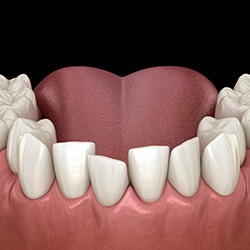
Crowded, overlapping teeth can certainly stand out when you smile. On top of that, they can also be very difficult to brush and floss properly, thus hindering your ability to maintain proper oral hygiene. Fortunately, many cases of overcrowded teeth can be corrected with Invisalign; the treatment can move your teeth in order to ensure that there’s an adequate amount of space.
Gaps Between Teeth
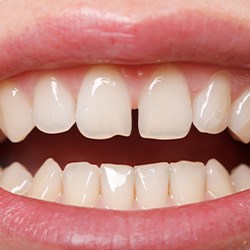
If there’s too much space between your teeth, it can make it easier for harmful bacteria and food debris to accumulate. In the long term, it could result in gum disease and cavities. Invisalign can often be used to close the gaps in your grin in order to protect your oral health while improving your appearance at the same time.
Overbite
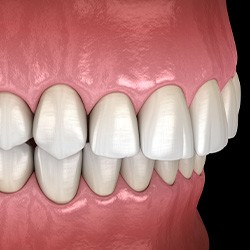
It’s normal for the upper teeth to stick out slightly in front of the lower teeth when you close your mouth. However, if they protrude too much, the resulting overbite can put an excessive amount of pressure on your jaw, resulting in serious pain. Furthermore, some of your teeth might wear down faster than normal. It’s sometimes possible to correct an overbite with the help of Invisalign.
Underbite
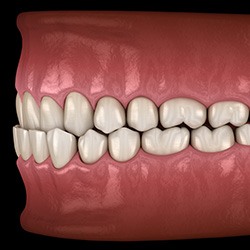
An underbite is the opposite of an overbite, occurring when the lower teeth are too far in front of the upper teeth. An underbite can make it hard to chew your food properly, and it can contribute to breathing problems; in some circumstances, it could even lead to sleep apnea. It may be possible to correct your underbite with Invisalign depending on how severe it is.
Crossbite
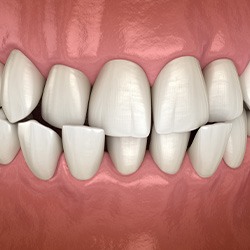
Sometimes certain lower teeth might erupt at an angle, causing them to jut out in front of the upper teeth. This is known as a crossbite, and it can lead to loose teeth, receding gums, enamel damage, and other consequences. Our team can take a look at your crossbite and determine whether Invisalign can be used to correct it so that all of your teeth are in their proper alignment.
Open Bite
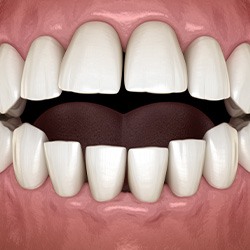
An open bite is relatively rare compared to other types of bite issues. It’s a condition where the upper and bottom teeth do not make contact when you bite down. This can prevent you from properly chewing your food, and it can interfere with your ability to clearly pronounce certain words. Our team may be able to use Invisalign in order to improve the pattern of your bite so that it can function normally.
After Your Invisalign Treatment
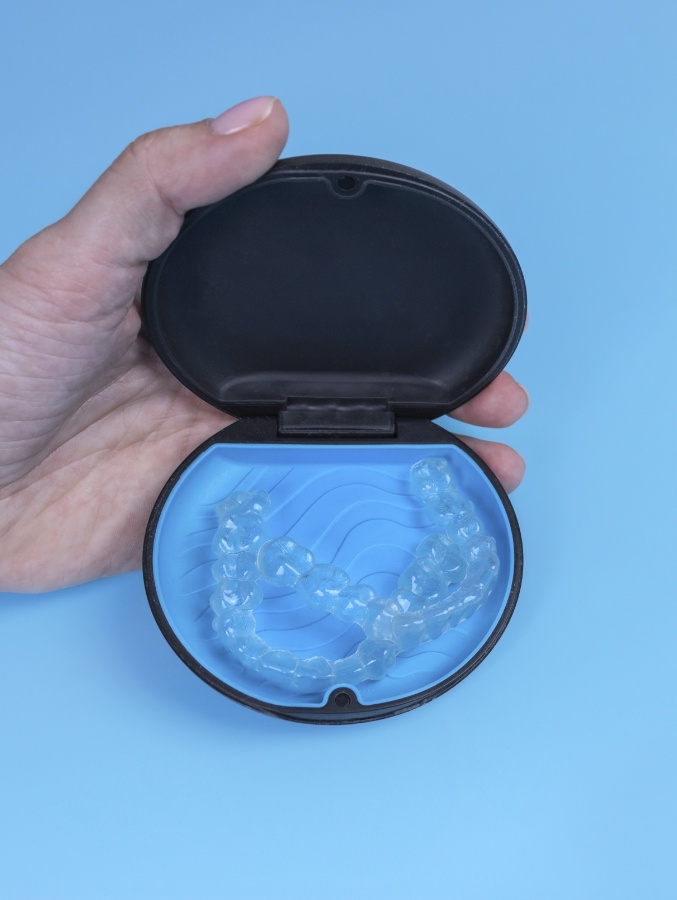
Teeth that have been realigned with orthodontics tend to drift back into their previous position after treatment is completed. The only way to avoid this relapse is by diligently wearing retainers. Once you have finished the Invisalign treatment, you will be fitted with these clear retainers that look similar to the Invisalign trays. You will begin wearing the retainers full-time, but most patients are able to reduce their retainer wear to nighttime only after a few months.
Living with Invisalign Aligners
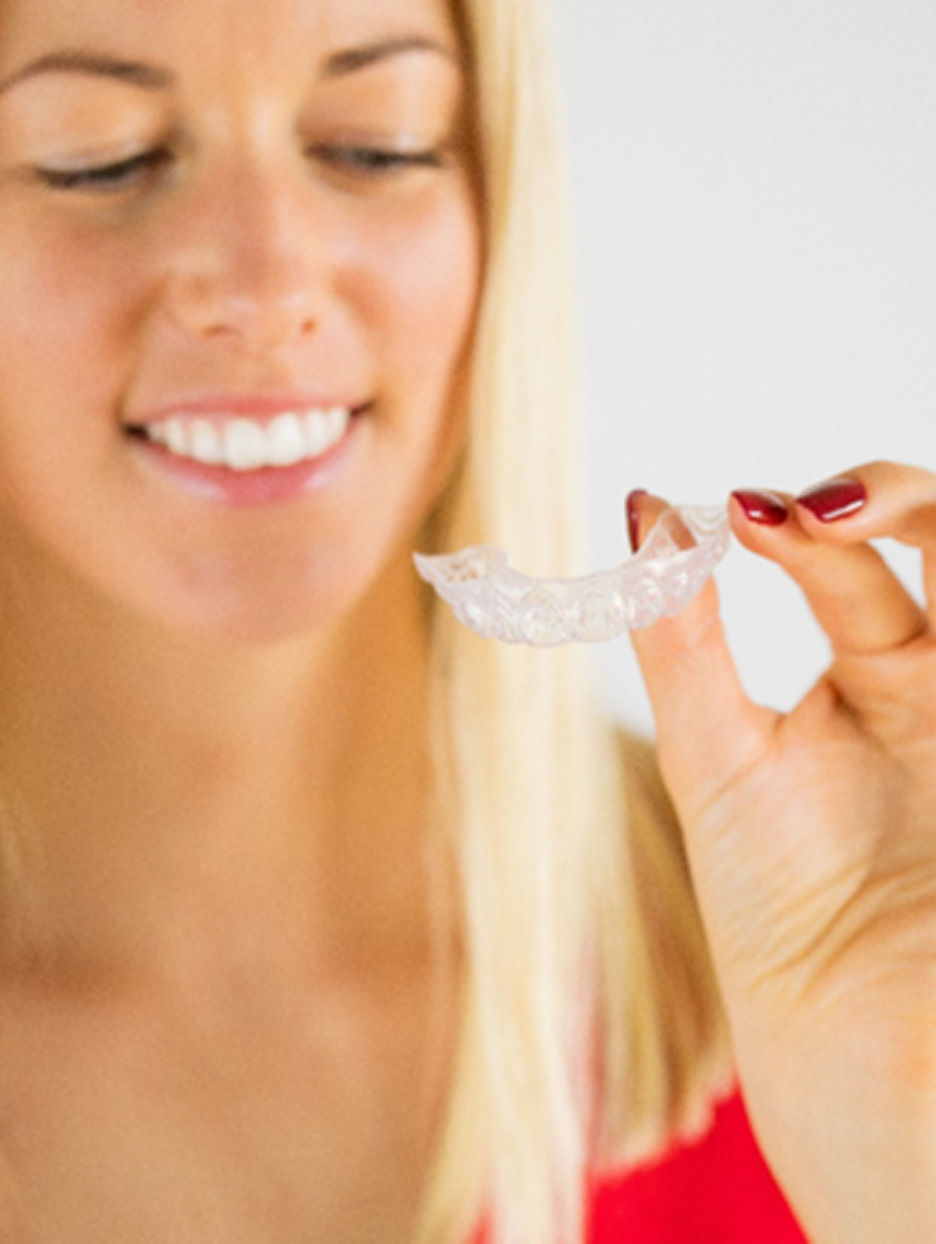
One of the most important aspects of the Invisalign process is patient compliance. Because the aligners can be removed at any time, it’s ultimately up to you to make sure that you’re following all the right steps for wearing them and taking care of them. Our team will give you detailed instructions for living with Invisalign aligners once you begin the treatment, but here are some tips that are worth learning ahead of time.
Wearing Your Trays
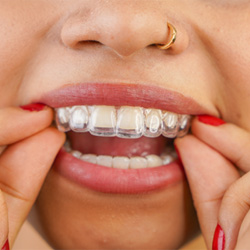
The aligners can only move your teeth if you wear them for most of the day. Generally speaking, they should stay in your mouth for about 20 to 22 hours on a daily basis. You should only take them out when you’re about to enjoy a meal or when it’s time to brush and floss your teeth. Be very mindful of how long your aligners are out of your mouth so that you can consistently meet your required wear time.
Cleaning Your Aligners
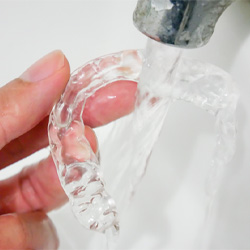
Any time you take your aligners out of your mouth, you should clean them before wearing them again. Rinse them off with lukewarm water; do not use hot water that might warp the plastic. After rinsing, you can brush your aligners with a soft-bristled toothbrush. Additionally, it’s recommended that you regularly soak your aligners in water mixed with Invisalign cleaning crystals.
Eating & Drinking

You’ll have the freedom to eat and drink whatever you want during your Invisalign treatment. All you need to do is remember one simple rule: always take your aligners out before eating or drinking anything that isn’t water. That way, you can avoid inadvertently damaging or staining your aligners while enjoying your meal or snack. Remember to keep your aligners in their case so that you can be sure that they’re in a safe place until you’re done eating.
Losing or Damaging a Tray
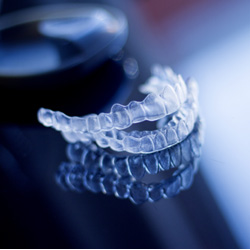
Accidents happen; even if you’re generally very careful, there’s a chance that you could end up breaking a tray or losing it altogether. If that happens, call our office immediately to let us know. We’ll explain what your next steps should be based on the situation. You may be able to move on to the next aligner in the series early if you were almost done with the current one. Otherwise, you might need to go back to wearing a previous aligner until we can provide you with a replacement.
Routine Check-Ins

Throughout the Invisalign process, you’ll need to make room in your schedule to visit our office roughly every four to six weeks. These visits give us the chance to provide you with the next batch of aligners. On top of that, we can take a look at your teeth and confirm that they’re moving as they should; if there are any unexpected developments, we can take the appropriate steps to address them. Feel free to use these routine appointments as an opportunity to ask any questions you might have about your Invisalign treatment.
How Can Dental Technology Improve My Invisalign Treatment?
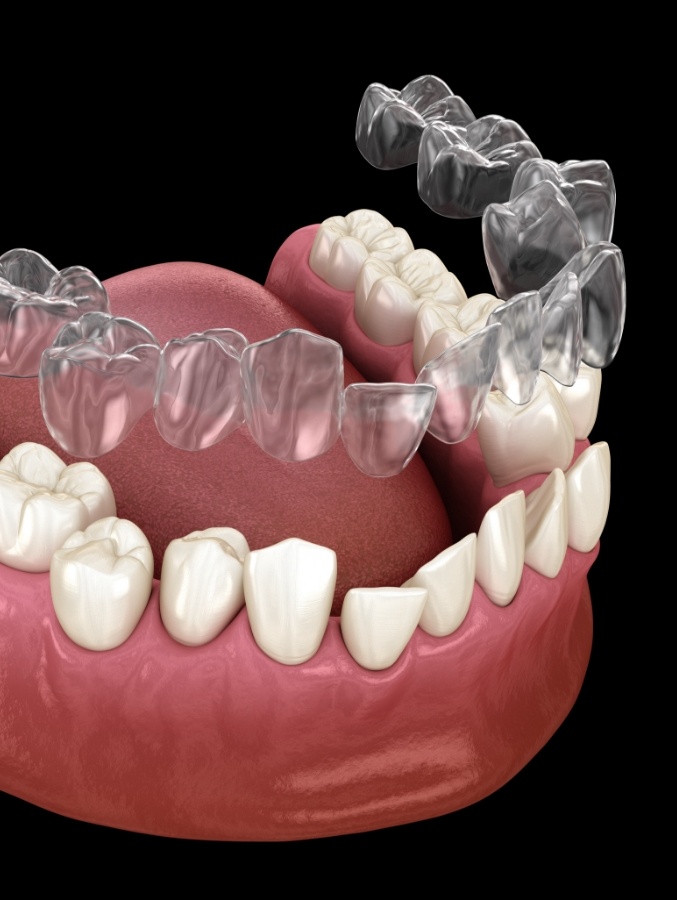
To enhance the results you receive when choosing Invisalign, we use the iTero Lumina Scanner. Due to its scanning designs and capabilities, you benefit from next generation technology as it removes the need for traditional impressions.
The unique image sensor captures 6,000 frames per second to produce real-time 3D visualizations. This not only saves time, but also improves the accuracy of your treatment by creating highly detailed images that can be viewed and magnified on display screens.
With advanced digital impressions, there is less room for error while streamlining the process to receiving the aligners. With Invisalign Certified Connectivity, the scanner produces 10 times fewer rejections, 7 times fewer fit issues, and makes ClinCheck setups as much as 50% faster. Overall, it promotes the patient experience with more simulated outcomes to provide superior results.
In addition, you can see how they will be moved through each phase of the process while also seeing what your new smile will look like even before committing to your treatment.
Using the detailed images, the scans are sent digitally to the lab to create printed models and orthodontic appliances, like your Invisalign aligners.
As technological advancements continue to improve the dental field, you will benefit from an enhanced treatment process. With the iTero Lumina scanner, you will enjoy predictable and accurate results while you work toward achieving a healthy, beautiful smile.
Understanding the Cost of Invisalign
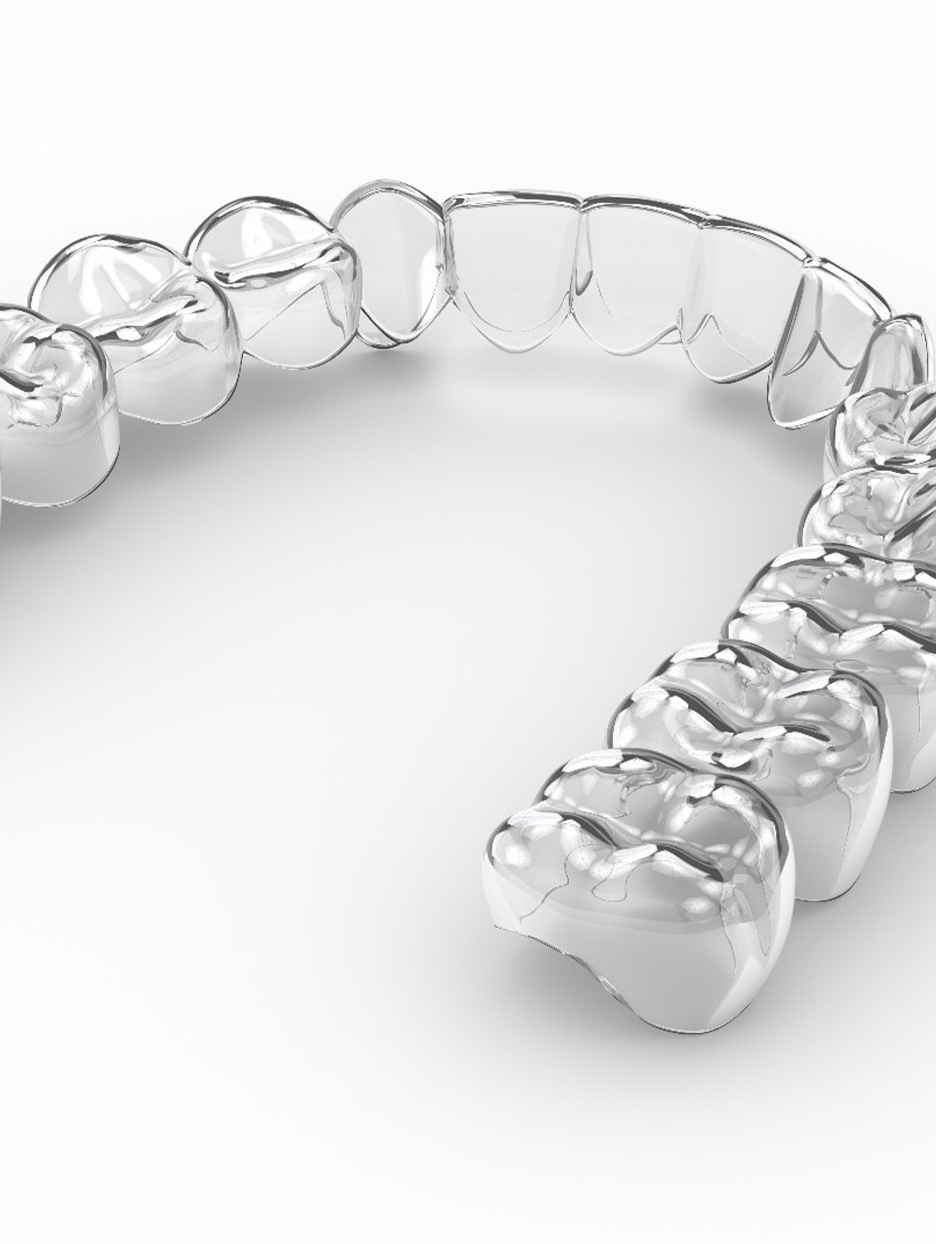
Invisalign is a treatment that you need to be willing to commit to for the long term, so before you begin, you should make sure that you understand what the overall cost will look like. Since the Invisalign process is different for every patient, the final price can vary from case to case. When you visit our office for your initial Invisalign consultation, our team can give you an estimate and explain anything you might want to know about the cost.
Factors That Affect the Cost of Invisalign
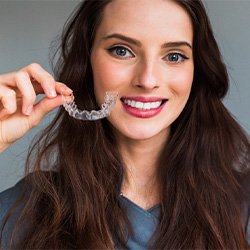
The length of your Invisalign treatment will play a large role in determining how much you end up paying for it. The longer your treatment takes, the more aligners you will likely need – and naturally, more aligners equals a higher cost. The nature of the orthodontic issues being corrected matters as well; more complex cases tend to be more costly to treat.
It should be noted that while many Invisalign treatments involve both arches of teeth, sometimes patients may only need aligners for the upper arch or the lower arch. If you are only having one arch straightened, you can typically expect to pay less.
Finally, keep in mind that the Invisalign process heavily depends on you wearing your aligners for at least 20 to 22 hours a day. If you remove them too often, the treatment might take longer, which can add to your overall cost.
Does Dental Insurance Cover Invisalign?
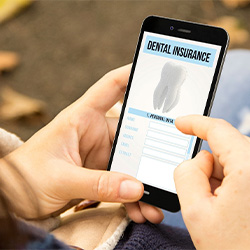
Some insurance companies will help pay for Invisalign as part of their orthodontic coverage. This isn’t the case for every insurance provider, though; you should double-check your plan to make sure that you understand your benefits before you start the Invisalign process. We can review your insurance plan with you if there’s something you want to clarify, and if any claims need to be filed, you can count on us to handle the paperwork.
Options for Making Invisalign Affordable
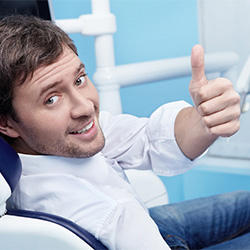
How can you save money on Invisalign without dental insurance? One strategy is to sign up for our dental membership plan; our standard adult plan and our standard senior plan both offer $500 off Invisalign along with other benefits. You may also want to think about applying for CareCredit financing so that you can pay for your treatment in manageable installments over several months’ time.
Invisalign FAQs
From who is a good candidate to what you can expect after treatment, we’ve covered a lot of information about Invisalign in Cary above. With that being said, it’s natural to have some lingering questions. After all, using clear aligners truly is a unique process. That’s why we’re answering some of the most common questions we hear from patients below. As always, if you would like to speak directly with our team, don’t hesitate to request an appointment!
Is wearing Invisalign aligners uncomfortable?
Worried that wearing your clear aligners will be painful? It’s not an uncommon concern. Fortunately, you have nothing to fear. While you may experience some discomfort while transitioning to each new set of trays, the sensation is often short-lived and is nothing that can’t be remedied with a cold compress or an over-the-counter pain reliever. In fact, since each tray is custom-made and metal-free, many patients find Invisalign to be much more comfortable than traditional braces!
How long does Invisalign treatment take?
The answer depends on a number of factors, like how severe your orthodontic issue is. Typically, however, it takes patients 12-18 months to work through their series of clear aligners. That treatment timeline can be extended if you neglect to wear your trays for the recommended amount of time, don’t transition to each new set properly, or neglect to keep up with a solid oral hygiene routine. In short, to see your new and improved smile sooner rather than later, make sure to follow all of the instructions our cosmetic dentist in Cary gives you.
What foods will I be able to eat during my Invisalign treatment?
Since your Invisalign clear braces can be removed, there isn’t a lengthy list of dietary restrictions that accompany the teeth-straightening process. There are, however, a few things you should avoid for the sake of your oral health. After all, dental problems like cavities and gum disease can delay your treatment timeline. So, exercise moderation with sugary, acidic, and extremely hard foods. You should also avoid unhealthy dental habits altogether, like chewing on ice or using your teeth as tools.
How long do I need to wear my Invisalign aligners for each day?
To gradually guide your teeth into their properly aligned positions, your clear aligners need to be worn for 22 hours a day. Since that only leaves you with 2 hours of non-wear time, it’s important to be strategic about your schedule. For example, consider soaking your Invisalign trays in cleaning crystals while eating dinner so food particles, plaque, and bacteria can be removed from their surface while you enjoy your meal.
Can I get Invisalign aligners if I’ve had metal braces before?
Possibly! In fact, many patients have used Invisalign to address orthodontic relapse. The best way to find out if you are a candidate for clear aligners is by scheduling an appointment with our skilled cosmetic dentist, Dr. Koch. During this visit, he will take a look at the position of your teeth, assess the state of your oral health, learn about your smile goals, and determine if Invisalign is right for you!
How Much Does Each Aligner Move My Teeth?
The process of straightening your smile with Invisalign is very gradual. Each set of aligners is designed to only move the teeth by a small amount. This is because if the teeth moved too much at once, it could result in a number of complications, such as root resorption. Thus, it’s better to reposition the teeth a little bit at a time.
Generally speaking, you can expect each clear aligner to move your teeth by about a quarter of a millimeter. Each aligner represents a necessary step toward a straighter smile. Make sure that you wear each aligner for the required amount of time; you don’t want to switch to the next set too early and start moving the teeth further before they’re ready.
How Do I Keep My Aligners Clean?
If you want to keep your aligners as clean as possible, there are several steps that you need to follow.
- Rinse your aligners off with water every time you take them out of your mouth. Make sure the water is lukewarm; if it’s too hot, it could warp the aligners and change the way they fit.
- Soak the aligners at least once a day with denture cleaner or Invisalign cleaning crystals.
- Always brush and floss your teeth before you put your aligners back in. This will help you get rid of food particles that could get trapped between your aligners and your teeth.
- Brush your aligners regularly with a soft-bristled toothbrush and unscented soap. Do not use the same toothbrush that you clean your teeth with.
How Long Do I Need to Wear Retainers After Treatment is Finished?
Once your Invisalign treatment is complete, you will need to wear retainers to ensure that your teeth stay in their new positions. At first, you will need to keep your retainers in your mouth at all times. This helps stop the teeth from moving while the bone around them is being remodeled. After about three months, you can switch to only wearing your retainers at night. Note that you will need to keep using your retainers for life if you want to maintain the results of your Invisalign treatment.
How Often Do I Need to Have My Aligners Evaluated?
It will be necessary for you to periodically visit our office so that we can take a look at your aligners and your smile in order to confirm that your treatment is going as expected. You can usually expect to visit us every 6 to 8 weeks. If we find any sign that something may have gone wrong with the treatment process, we will inform you immediately, and we will explain what steps can be taken to correct the problem and get you back on the path to a straighter smile.






